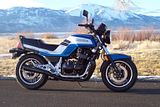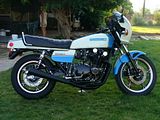Terry
Announcement
Collapse
No announcement yet.
Anything to be learned from exhaust temps..
Collapse
X
-
 TheNose
TheNose
Anything to be learned from exhaust temps..
I was given a temp gun and wondered if I could tell anything from the exhaust temps. I measured the four pipes and found about a 40 degree difference between the two inner pipes versus the two outer pipes. The inner ones were around 175 degrees while the two outer ones were around 135. I suppose the inner ones are running leaner than the others, but which is more correct?
TerryLast edited by Guest; 02-12-2009, 01:21 PM.Tags: None
-
it is a good tool to collect really good information.
differences in temperature after they level off can help you to get the perfect idle mixture.
every bike runs at a little different temp. multiple variables involved. \
but your numbers seem a little low.
I would say a tolerance of 25 + or - degrees is suitable.SUZUKI , There is no substitute
-
 TheNose
TheNose
Thanks for the feedback. I think I will start collecting data and see if I can make some adjustments.
Terry
Comment
-
 TheCafeKid
TheCafeKid
your inner two pipes will also generally run a little hotter like trippivot says, because those two cylinders will generally run hotter anyway due to not being able to shed heat as efficiently as the outer because they're encased by the outers.
Comment
-
 TheNose
TheNose
Thanks guys! You've been helpful because I didn't know if I was barking up the wrong tree or not.
Now, if I could just get Earlfor's opinion I would have a full house.
Terry
Comment
-
Yes, as trippivot has said it's a valuable tuning tool. It's a very good indicator of carb balance and mixture settings. But you will get different temps depending on how hard you have ridden the bike and how high the ambient air temps are at the time you do your readings.
My last readings were done after I had ridden the bike reasonably hard in 28 deg C ambient air. The readings were taken after crusing to a stop and some 2 minutes after turning off the engine. The range was 275-295 deg C. The inner pipes were the higher readings.
To get an accurate take on the readings, you need to measure a set distance from the flange ring and mark each pipe with chalk, accordingly. If you aren't accurate with aiming the infared dot at an identical part of each pipe, you will get inaccurate readings possibly causing unwarranted adjustments.
If the temps vary by more than 30 degs, I would be looking at making tuning adjustments.:) The road to hell is paved with good intentions......................................
GS 850GN JE 894 10.5-1 pistons, Barnett Clutch, C-W 4-1, B-B MPD Ignition, Progressive suspension, Sport Demons. Sold
GS 850GT JE 1023 11-1 pistons. Sold
GS1150ES3 stock, V&H 4-1. Sold
GS1100GD, future resto project. Sold
http://i155.photobucket.com/albums/s...s/P1000001.jpg
http://i155.photobucket.com/albums/s...s/P1000581.jpg
Comment
-
 TheCafeKid
TheCafeKid
Good point there 49er. The temp difference at the flange, and say, at the bend in the header can be substantially different. As much as 75 degrees or more.Originally posted by 49er View PostYes, as trippivot has said it's a valuable tuning tool. It's a very good indicator of carb balance and mixture settings. But you will get different temps depending on how hard you have ridden the bike and how high the ambient air temps are at the time you do your readings.
My last readings were done after I had ridden the bike reasonably hard in 28 deg C ambient air. The readings were taken after crusing to a stop and some 2 minutes after turning off the engine. The range was 275-295 deg C. The inner pipes were the higher readings.
To get an accurate take on the readings, you need to measure a set distance from the flange ring and mark each pipe with chalk, accordingly. If you aren't accurate with aiming the infared dot at an identical part of each pipe, you will get inaccurate readings possibly causing unwarranted adjustments.
If the temps vary by more than 30 degs, I would be looking at making tuning adjustments.
Comment
-
I dont think a thermometer like that will be accurate enough to be used for carb adjustments.
Alot of the piston airplanes I see have Exhaust Gas temp probes inserted right into each of the 6 exhaust stacks through an 1/8" hole and held on by a SS hose clamp. These temps are pretty accurate and are used as a tool for troubleshooting engine problems and adjusting air / fuel mixture. The probes are a couple hundred bucks each and the monitor is a grand. After installation its like $3k.82 1100 EZ (red)
"You co-opting words of KV only thickens the scent of your BS. A thief and a putter-on of airs most foul. " JEEPRUSTY
Comment
-
 flyingace
flyingace
The problem I see with exhaust pipe temps is that there is nothing to measure them against. The factory doesn't supply normal vs. abnormal temps. Your readings may be great or way off - who can say with any certainty? If the temps were 75 degrees apart, would you tear down your bike to fix it?
Just IMO, but pipe temps are of very little diagnostic use.
Comment
-
Who knows what the correct temps should be for any given parameters/set up? The point of taking the temps is to confirm that you aren't way off with your burnoff rates, from one cylinder to another. As Bruce has suggested, plug reads are the main indicator. When plug readings are marginally different and you suspect a slightly leaner or richer condition on any given pot, the temp comparison can confirm how much adjustment is required to mixtures to maximise the burnoff.Originally posted by flyingace View PostThe problem I see with exhaust pipe temps is that there is nothing to measure them against. The factory doesn't supply normal vs. abnormal temps. Your readings may be great or way off - who can say with any certainty? If the temps were 75 degrees apart, would you tear down your bike to fix it?
Just IMO, but pipe temps are of very little diagnostic use.
Its not a black science, just another diagnostic tool. If there were no benefits to exhaust temp analysis, why would aircraft manufacturers bother with the added expense?Last edited by 49er; 02-13-2009, 03:04 AM.:) The road to hell is paved with good intentions......................................
GS 850GN JE 894 10.5-1 pistons, Barnett Clutch, C-W 4-1, B-B MPD Ignition, Progressive suspension, Sport Demons. Sold
GS 850GT JE 1023 11-1 pistons. Sold
GS1150ES3 stock, V&H 4-1. Sold
GS1100GD, future resto project. Sold
http://i155.photobucket.com/albums/s...s/P1000001.jpg
http://i155.photobucket.com/albums/s...s/P1000581.jpg
Comment
-
 Ludeykrus
Ludeykrus
They are of huge diagnostic use and tuning use if you have baselines to compare them against. This is the same for anything, though. Compression readings, O2 sensor/ air-fuel readings, etc. Search for 'EGT tuning' in automobiles, since these ideas are similar.Originally posted by flyingace View PostJust IMO, but pipe temps are of very little diagnostic use.
I would say if you can get a baseline reading from a well-tuned or well-running stock bike, you can make some good assumptions. And yes, the inside cylinders (or back-side in other bikes) will always run hotter.
Comment
.png)


Comment